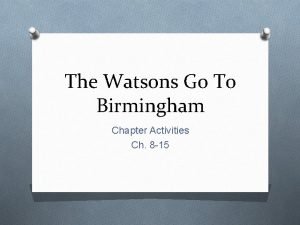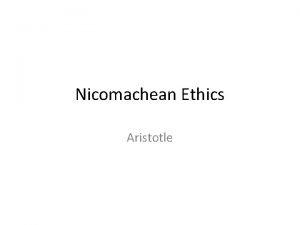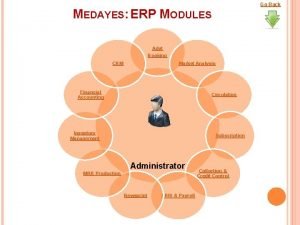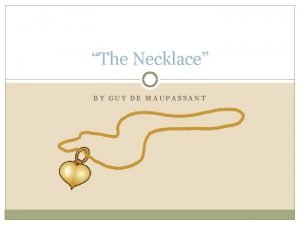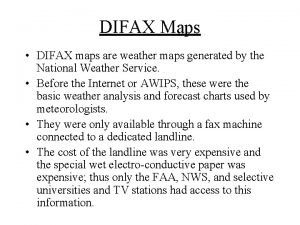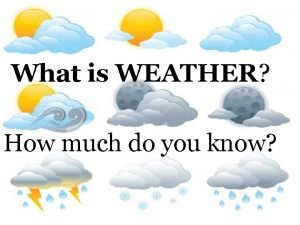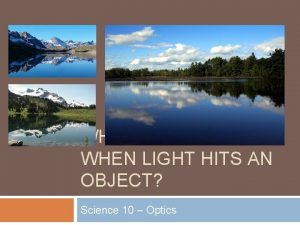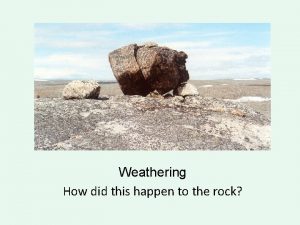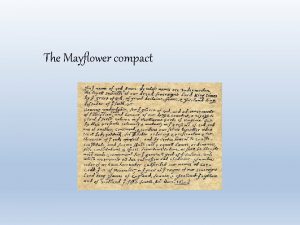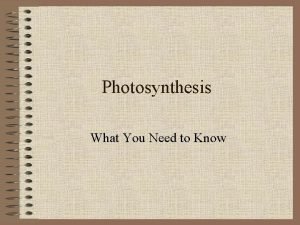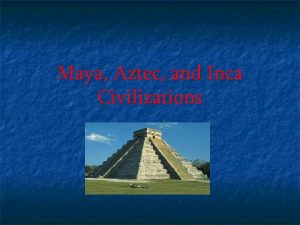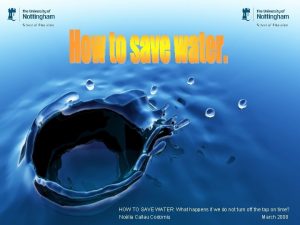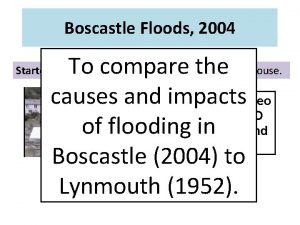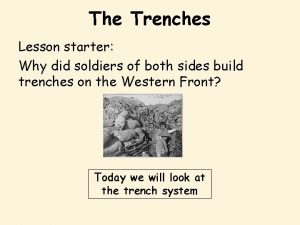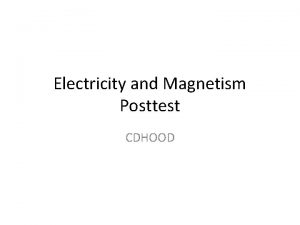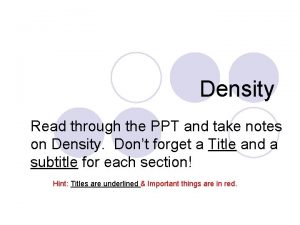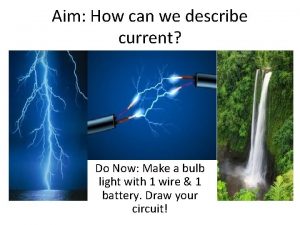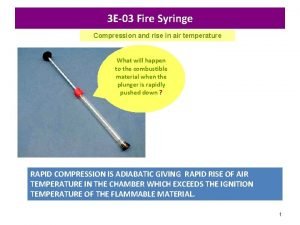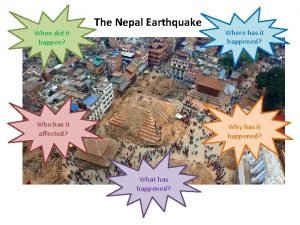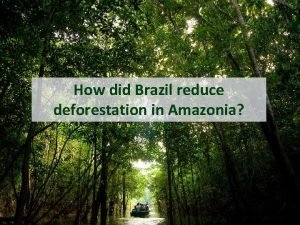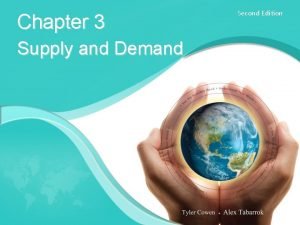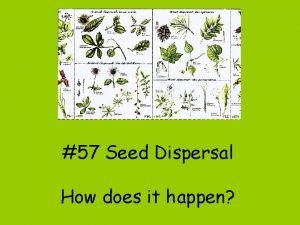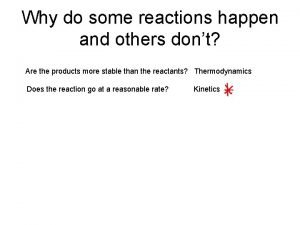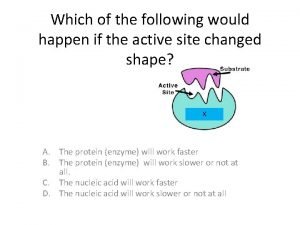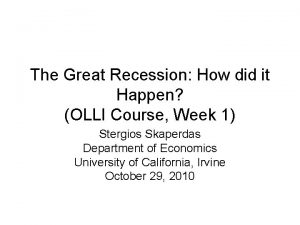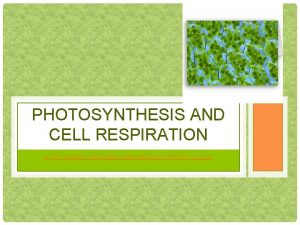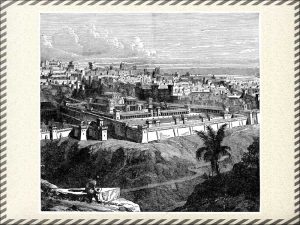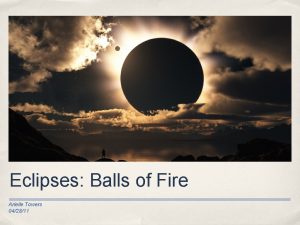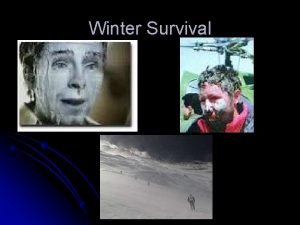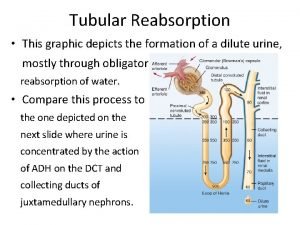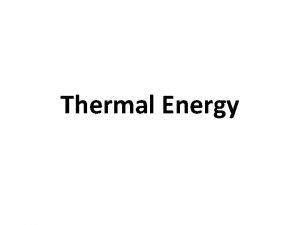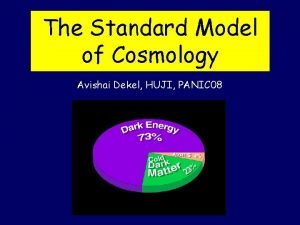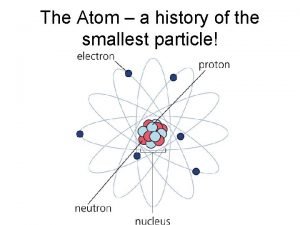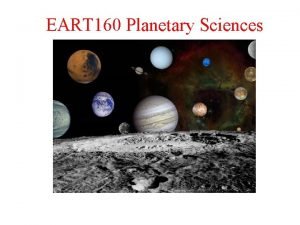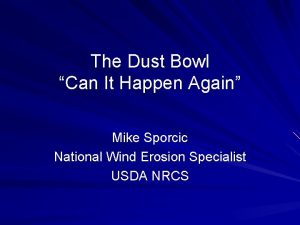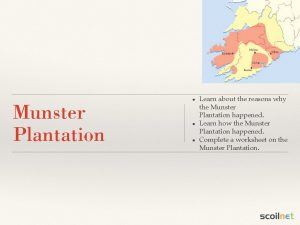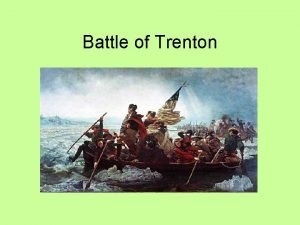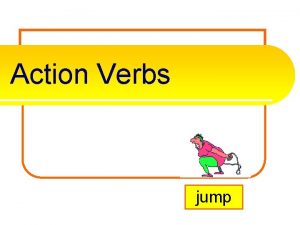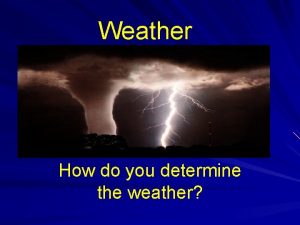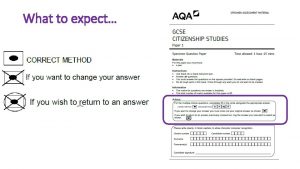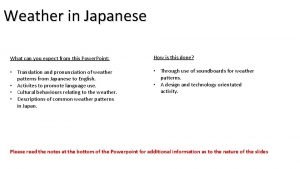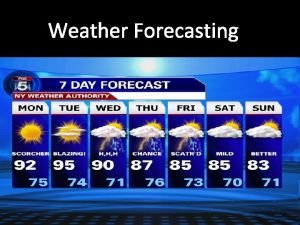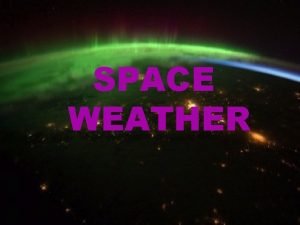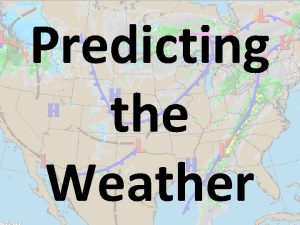WEATHER What do you expect to happen to




















































































































- Slides: 116

WEATHER What do you expect to happen to the blue line? The red line?

Weather: 3 -7 -12 @ 10: 30 AM

Temperature Determines amount of water vapor in air What might cause this? Evaporation! Rate of evaporation exceeds rate of condensation as temperature rises

Humidity Amount of water vapor in the air Relative humidity Amount of water vapor in air This is the maximum amount of water vapor possible at that temperature Given as a percentage

Condensation Process by which a gas (like water vapor) becomes liquid Occurs when temperature drops below dew point

Dew Point Temperature at which air becomes saturated and produces dew

Cloud A collection of millions of tiny water droplets or ice crystals Form as warm air rises and cools As cloud temperature drops below dew point, condensation occurs

Weather Patterns

Air Mass A large body of a specific air type Has the properties of the surface where it developed

Types of Air m c T P A Maritime Continental Tropical Polar Arctic


The Front Boundary between two air masses Four types: › Warm › Cold › Occluded › Stationary

Warm Front Warm air catches up to the cold air Warm air gently rises over cold air

Cold Front Cold air catches up with warm air Cold air slams into warm air Quick vertical rising of warm air THUNDERSTORM!


Occluded Front Two cool air masses merge and force up the warm air between them Strong winds Usually lots of precipitation

Stationary Front When pressure is equal between the cold air mass and warm air mass

Clouds

Cirrus clouds Ice clouds Over three miles high Below freezing temperatures even in summer Wind currents twist and spread the ice crystals into wispy strands

Cumulus Fluffy, white cotton ball clouds “Fair weather clouds”

Stratus Thin, white sheets covering whole sky Can appear to be fog

Special clouds Orographic Get shape from mountains or hills that force the air to move over or around them Refers to the transport of some property of the atmosphere or ocean, such as heat, humidity or salinity.

Lenticular Shaped like lenses Shape comes from hilly terrain or the way air rises

Mammatus is a term applied to a pattern of pouches hanging underneath the base of a cloud, often a cumulus or cumulonimbus. These pouches, typically measuring about half a kilometer in diameter, are often ragged, but may appear smooth. Their color is normally a bluish gray, the same as that of the host cloud, but direct illumination from the setting sun and other clouds may cause a gold or reddish cast.

Mammatus �Mammatus can persist anywhere from minutes to hours, diffusing and disappearing over time. �The mechanism of their production is poorly understood and has been little studied. The presence of very dry air beneath the cloud base is known to be a factor. �They are often associated with storms.




Nacreous clouds only occur at high polar latitudes in winter, requiring temperatures less than minus 176 degrees Fahrenheit (minus 80 degrees Celsius). A weather balloon measured temperatures at minus 189 degrees Fahrenheit (minus 87 degrees Celsius) on the day the photo was taken.

Nacreous clouds Resembling mother-of-pearl shells, they are produced when fading light at sunset passes through water-ice crystals blown along a strong jet of stratospheric air more than six miles above the ground.

Nacreous clouds

Effects of Cloud Cover During the day, Earth is heated by the sun Clear skies more heat to surface warm temp Cloudy skies less heat cooler temp

Forecasting and Clouds During the day, cloud cover makes for colder temperatures. What happens with cloud cover at night? This is when it traps heat in, resulting in a slower decrease

PRECIPITATION FORMATION

Rain Develops when growing droplets become too heavy to stay in the cloud. Can develop into ice crystals if cold enough As ice crystals pass into warmer air, the flakes turn into rain drops

Hail �Hail forms in cumulonimbus clouds as a strong updraft carries raindrops and ice crystals back up into the cloud where temperatures are below freezing and raindrops will freeze into sleet or graupel (frozen raindrops). �It is then carried up through the cloud where millions of supercooled water droplets collide with the ice surface and are instantly frozen, causing the graupel to become larger.

Hail When the now larger graupel or hailstone reaches the top of the cloud, it begins to fall back downward where the updraft is weaker. The hail falls back down into an area where the updraft is stronger and this cycle begins again with the hailstone growing another ring of ice. This cycle will continue and the hailstone will become larger until finally it becomes too heavy for the updraft to carry upward.


Key points of hail Layers continually grow on ice Stronger updraft creates bigger hail

Ice storm dangers Lines freeze Layers of ice

Freezing rain Causes terrible driving conditions Supercooled rain that freezes when meeting cold surfaces Found in narrow band on cold side of warm front Temp just at or just below freezing

The Freeze Supercooled drops aren’t frozen until they hit the ground

Stationary Fronts Produces freezing rain Arctic air mass are shallow Produces severe winter weather

Effects of Snow Cover Earth’s surface usually absorbs sunrays This warms the air near the surface Snow will reflect the rays, some snow melts Fewer rays reaching surface means the Earth warms slowly

Forecasting and Snow When snow is present: Forecast lower daytime temperatures At night, snow on ground gives off heat Rapid cooling occurs Forecast cooler than if there was no snow

Air Currents What are the two types of wind?

Air Currents Wind: moving air Air always moves from High Pressure Low Pressure Two main types of wind: Local Wind Global Wind A Video

More on air Air always move from warmer to cooler Temperature advection refers to change in temperature caused by movement of air by wind Forecast using advection: Involves looking at wind direction and upstream temperatures (direction from where the wind is blowing) Warm advection, expect warming trend Cold advection, expect cooling trend

Local Wind Moves short distances Blows from any direction Examples: Sea breeze Land breeze

Global Wind Long distance Specific travel direction cause by Coriolis effect Once air has been set in motion it follows deflection from its path. This is a result of the earth’s rotation.

Global Winds Examples: Doldrums Trade Winds (30º N & S) Westerlies (30 -60º N & S) Polar Easterlies (Poles-60º N & S) Jet Streams: narrow belt of highspeed air (250 mph)


Zones of the Earth

F. Y. I. Doldrums comes from the Old English word meaning “foolish. ” People were considered foolish if they were caught sailing in this area. Trade Winds got their name because people used them to sail between Europe and America to trade.

Air Current Measurement Weather Vane: Direction Anemometer Speed

Effects of Wind At night, Earth’s surface cools by radiating heat toward space. On a windy night, warmer air above mixes down to surface. This occurs because winds are faster above than on surface.

Forecasting and Wind On a calm night, the maximum surface cooling takes place On a windy night, warmer air mixes downward to surface This prevents the temperature from dropping quickly Forecast Tip: Forecast slightly warmer on a windy night vs. a calm night

Energy Transfer

Energy transfer Most of Earth’s energy comes from the sun What happens when the energy gets here? 20% is absorbed by the atmosphere 30% is reflected back 50% absorbed by the surface

Three types of energy transfer Radiation Conduction Convection

Radiation Transfer by heat waves Example: Your skin starts to feel warm after you have been in the sun

Conduction Transfer of thermal energy from one material to another by direct contact Example: Touching a hot pan on a stove or barefoot on a hot sidewalk

Convection Transfer of thermal energy by the circulation of liquid or gas Example: Heating your house, lava lamps, heated pools

ATMOSPHERE

Atmosphere Blanket of gases around the Earth Protects us from harmful rays Always changing due to people breathing, trees, and cars

Composition Percentage Elements 78% Nitrogen 21% Oxygen 1% Others

The other gases Mostly composed of: - Water vapor - Carbon dioxide - Argon

The layers Divided by temperature: Thermosphere Mesosphere Stratosphere Troposphere Ground Level Outer layer Lowest temperatures Ozone Layer Weather occurs


AM Radio The ionosphere reflects AM radio waves. When it is clear outside, the waves can be transferred around the world.

Troposphere Contains 90% of the atmosphere’s total mass Almost all of the Earth’s CO 2, water vapor, cloud, air pollution, weather, and life forms are here


Temperature Variation Due to solar energy absorption Warmer = more energy absorbed Cooler = less energy absorbed

Tornados and Hurricanes

Movements of High Air in the Atmosphere

Severe Storms Thunderstorms • Thunder, lightning • Gusty winds, heavy rain, hail Form when warm, humid air rises in an unstable environment Estimated 2000 thunderstorms in progress, where are they located?

Thunderstorm Stages

Tornados Violent windstorms that take form of a rotation column of air called a vortex. This vortex extends downward from a cumulonimbus cloud. Most tornados form in association with severe thunderstorms.

Fujita Tornado Intensity Scale

Hurricanes Whirling tropical cyclones that produce winds of at least 119 km/h Most occur between 5 and 20 degrees north and south of the equator. North Pacific averages 20 per year.

Hurricane Development Usually occur in late summer when the water temperatures are warm enough to provide heat and moisture to the air. The eye is a zone of scattered clouds and calm averaging about 20 km in diameter at the center of a hurricane Eye wall is a doughnut shape area of intense cumulonimbus development and very strong winds that surround the eye.


Saffir-Simpson Hurricane Scale

PRESSURE AND THE ATMOSPHERE

Atmospheric Pressure Have you ever wondered why your ears pop on an airplane or in an elevator? This occurs when the pressure outside your ears becomes equal to the pressure inside your ears.

Atmospheric Pressure Gas has mass Gas takes up space Atoms in the atmosphere are pushed together by the mass above Definition: The force air exerts on objects it contacts

Factors of air pressure Elevation lower level = higher pressure Temperature cold air sinks so pressure increases Density high density = high pressure

Q & A If cold air sinks and warm air rises, Why is it cold at the top of a mountain? Not as many molecules are at available Lower density of air molecules Few molecules are available to transfer heat

Pressure and Storms High pressure = fair weather Low pressure = stormy weather

Measuring the pressure What unit of measurement is used on TV? Inches of Hg What do meteorologists use? Milibars = mb How do we measure it? barometer


The Water Cycle What percentage of the Earth’s surface is covered by water? How much does the atmosphere hold?

Evaporation What is evaporation? Water transfer into the atmosphere About 80% comes from oceans About 20% comes from inland waters and vegetation

Evaporation Most evaporated water exists as gas outside of clouds In what type of temperature is evaporation more intense? Warmer temperatures

Condensation What is condensation? Conversion of gas into liquid Occurs when warm air rises, cools, and loses capacity to hold vapor.

Condensation Upward motions that generate clouds can be produced by: Convection in unstable air Convergence from cyclones Lifting of air by fronts Lifting of air by topographic features

Transport of water Moisture transports as clouds Movement by jet stream or circulation of breezes


Precipitation Water transfer from clouds back to surface Forms include: Hail Snow Sleet Freezing rain

Groundwater Water that is beneath the surface in one of two soil layers Zone of aeration nearest surface Zone of saturation next layer down

Reservoir A pond, lake, or basin, either natural or artificial, for the storage, regulation, and control of water. Luther Aadland demonstrates this


Ogallala Aquifer Massive supply of water Possible contamination Reality of threat


Transpiration Evaporation of water from leaves and stems of plants Accounts for 10% of evaporation

Runoff Movement of land water to oceans Consists of precipitation that does not evaporate Does not transpire And does not enter the groundwater system

OCEANS

THE FORMATION After the Earth cooled, water vapor in the atmosphere condensed, causing rain to fill the first ocean. Currently there are four major divisions: Arctic Ocean Indian Ocean Atlantic Ocean Pacific Ocean

ABOUT THE WATER Salinity: measurement of dissolved solids in liquid The ocean salinity is 35 g per 1000 g Salt is the majority of dissolved solid

FACTORS AFFECTING SALINITY Evaporation Circulation Freshwater inflow

MOVEMENT OF OCEAN WATER Surface currents: Stream like movement of water at or near the surface of the ocean Affect climate by cooling or heating the coastline

DEEP CURRENTS Stream-like movement of water far below the surface Deep and surface currents are caused by Convection

TIDES Daily movement of ocean water that changes level of surface High tide and low tide are dependent upon the moon’s orbit

TIDE INFORMATION The moon’s pull is strongest on the side of the Earth facing the moon. This causes a bulge on the side facing the moon and directly opposite. (High tide) The sun can affect tides. Tidal range is the difference between low and high tide.

SPRING TIDE When the sun, moon, and Earth are aligned Maximum daily tidal range

NEAP TIDE When the sun, Earth, and moon are perpendicular Minimum daily tidal range
 Sequence clue words
Sequence clue words Sqprs
Sqprs What do you expect to learn
What do you expect to learn Making homes happen 4 you
Making homes happen 4 you Bis know your customer
Bis know your customer Station plot
Station plot Poem whether the weather
Poem whether the weather Her poem clothes
Her poem clothes It's sunny and windy
It's sunny and windy Weather vs whether
Weather vs whether Heavy weather by weather report
Heavy weather by weather report Capital weather gang weather wall
Capital weather gang weather wall Work immersion work ethics
Work immersion work ethics Decide verb pattern
Decide verb pattern Factors of care a patient can expect
Factors of care a patient can expect Reemployment
Reemployment Ap psychology unit 9
Ap psychology unit 9 Never be predictable
Never be predictable Parents impose rules and expect obedience
Parents impose rules and expect obedience Womb to tomb psychology
Womb to tomb psychology Introduction to hospitality 7th edition
Introduction to hospitality 7th edition Alone together book review
Alone together book review What is an ultra glide watsons go to birmingham
What is an ultra glide watsons go to birmingham Dont expect more
Dont expect more Expect the unexpected
Expect the unexpected Love fiilinin 3. hali
Love fiilinin 3. hali Expect tool
Expect tool Expect prefix and suffix
Expect prefix and suffix Why had m. loisel been saving 400 francs?
Why had m. loisel been saving 400 francs? Do you love rain
Do you love rain Agree or disagree questions about life
Agree or disagree questions about life If you think you can you can poem
If you think you can you can poem Tell me what you eat and i shall tell you what you are
Tell me what you eat and i shall tell you what you are I follow you wherever you go
I follow you wherever you go How do you read a weather depiction chart?
How do you read a weather depiction chart? Weather how much do you know
Weather how much do you know Where did happen
Where did happen What's the worst that could happen short story questions
What's the worst that could happen short story questions When light hits an object
When light hits an object Which type of weathering
Which type of weathering Why did the mayflower compact happen
Why did the mayflower compact happen What is haymitch's training strategy for katniss and peeta
What is haymitch's training strategy for katniss and peeta Happen en presente continuo
Happen en presente continuo Tipp-ex sonate
Tipp-ex sonate Where does the photosynthesis occur
Where does the photosynthesis occur Tenochtitlan today
Tenochtitlan today In what section of earth do earthquakes happen?
In what section of earth do earthquakes happen? Tap water
Tap water Explanation text rainbow
Explanation text rainbow Which best explains why the moon has phases?
Which best explains why the moon has phases? College make it happen
College make it happen What phase is
What phase is Boscastle flood responses
Boscastle flood responses Trench foot
Trench foot Why did the homestead strike fail
Why did the homestead strike fail Making the pyp happen
Making the pyp happen What will happen
What will happen Why does it happen
Why does it happen Why does this happen
Why does this happen What will happen
What will happen When did nepal earthquake happen
When did nepal earthquake happen What's the worst that could happen short story questions
What's the worst that could happen short story questions Where did the battle of vicksburg happen
Where did the battle of vicksburg happen The very attempt not to communicate communicates something
The very attempt not to communicate communicates something Why did this happen
Why did this happen If garden gnomes regain popularity, what will happen?
If garden gnomes regain popularity, what will happen? What should happen if a nobleman dies during surgery
What should happen if a nobleman dies during surgery How does seed dispersal happen
How does seed dispersal happen Why does it happen
Why does it happen Which of the following would happen
Which of the following would happen What should happen to a boy who slaps his father
What should happen to a boy who slaps his father November 5 1605
November 5 1605 When did it happen
When did it happen Why did this happen
Why did this happen Where did this happen
Where did this happen Word equation for photosynthesis
Word equation for photosynthesis Where did happen
Where did happen Why does it happen
Why does it happen Didnt happen bet
Didnt happen bet Does happen
Does happen Code of hammurabi
Code of hammurabi How eclipse happen
How eclipse happen Epicenter of earthquake
Epicenter of earthquake Why convection cannot happen in solids
Why convection cannot happen in solids Why do things happen the way they do
Why do things happen the way they do Why did operation rolling thunder happen
Why did operation rolling thunder happen Renal reabsorption
Renal reabsorption What will happen if tom robinson loses his last appeal?
What will happen if tom robinson loses his last appeal? Graph of kinetic energy vs temperature
Graph of kinetic energy vs temperature What caused the big bang
What caused the big bang Mechanical digestion
Mechanical digestion Why did the battle of lexington and concord happen
Why did the battle of lexington and concord happen What would happen
What would happen Products of photosynthesis
Products of photosynthesis What will happen?
What will happen? What will happen
What will happen Explain why did it happen
Explain why did it happen What two important events happen at frightful’s nest?
What two important events happen at frightful’s nest? What will happen?
What will happen? Why does happen
Why does happen Can the dust bowl happen again
Can the dust bowl happen again Pictures of the dust bowl
Pictures of the dust bowl Munster plantation
Munster plantation Little red riding hood foreshadowing
Little red riding hood foreshadowing Happen 名詞
Happen 名詞 Where did the battle of trenton happen
Where did the battle of trenton happen Is tried an action verb
Is tried an action verb You are the word at the beginning
You are the word at the beginning You thought that i was like you
You thought that i was like you Visual rhetoric
Visual rhetoric You can't turn right
You can't turn right Kicks for life
Kicks for life You remember what you were doing at this time yesterday
You remember what you were doing at this time yesterday You remember what you were doing at this time yesterday
You remember what you were doing at this time yesterday Homework oh homework i hate you you stink
Homework oh homework i hate you you stink They say sometimes you win some
They say sometimes you win some To take something that doesn't belong to you
To take something that doesn't belong to you






















